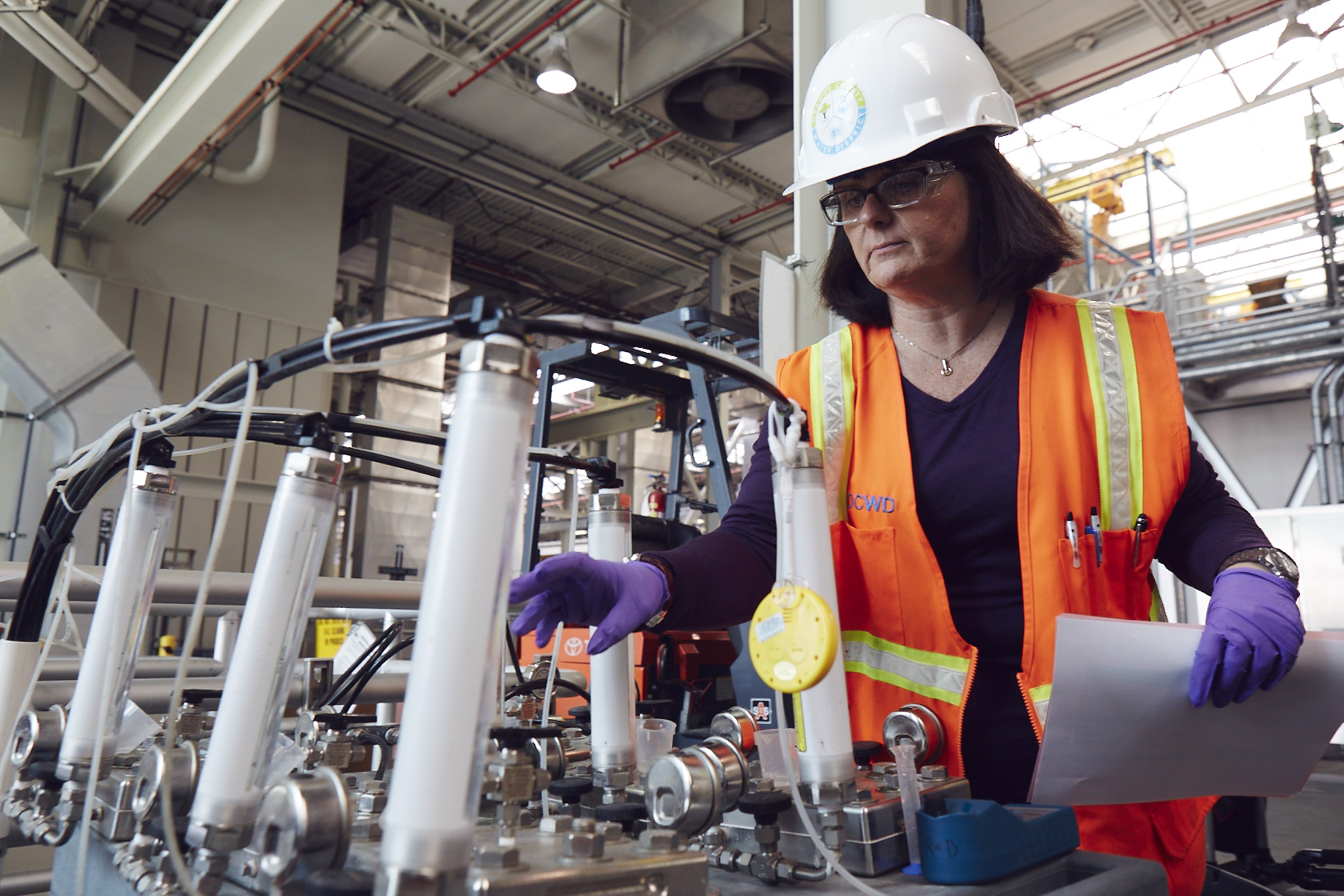Two water associations join forces for the first time to create certification for those taking the “waste” out of wastewater
By Lynn Lipinski

Jana Safarik, senior scientist at Orange County Water District, checks reverse osmosis cells in the research and development department. Courtesy of OCWD. Courtesy of Orange County Water District.
A new voluntary certification program created by two of California’s longest-standing water sector organizations aims to ensure that water and wastewater treatment operators are prepared and knowledgeable about advanced water treatment technologies and related control processes, such as membranes and advanced oxidation used to purify wastewater and other challenging source water.
The Advanced Water Treatment Operator (AWTO) certification program dovetails with the water sector’s move toward the “One Water” concept which stresses that all water — wastewater, stormwater, and drinking water — has value and should be managed as a resource. California’s advancement of direct potable reuse (DPR) builds momentum for making One Water a reality.
Slated to launch with a Grade 3 exam this spring, the AWTO certification program is under development by the California-Nevada Section of AWWA and the California Water Environment Association (CWEA). It seeks to validate knowledge of operators who will be charged with conducting stringent operations, maintenance and monitoring programs at complex DPR plants as well as other facilities such as those treating brackish or difficult source water such as stormwater. The certification will be open to all California and Nevada Grade 3 or higher drinking water treatment and wastewater treatment operators.
The AWTO Grade 3 exam is expected to be ready this spring. For more info and to sign up for email alerts visit AWTOperator.org.
“The potential for direct potable reuse in California spurred development of AWTO,” said Timothy Worley, executive director of the CA-NV Section. “The expert panel and advisory committee advising the State Water Resources Control Board’s Division of Drinking Water knew operator certification would be key in developing public trust and ensuring high quality. Our two organizations were the natural fit to take it on.”
Creating and running certification programs for water and wastewater treatment operators is nothing new for the CA-NV Section or CWEA. Both steered development of the state’s first certification programs for water and wastewater treatment, respectively, beginning as early as the 1930s. In 2018, both are forging new ground again by melding the best practices of water and wastewater treatment.
While CWEA and the CA-NV Section both saw their voluntary certification programs added as requirements under California law following passage of federal clean water and safe drinking water laws in the 1970s, neither of these existing certification programs covers all of the emerging and advanced technologies being used today in water and wastewater treatment, according to CWEA Executive Director Elizabeth Allan. “AWTO fills an important gap between the two,” Allan said. “The exam content is groundbreaking.”
Water agencies and other organizations agree. They have shown their support for the new certification program through funding as well as dedicating staff as subject matter experts and volunteers on the AWTO Certification Committee, led by Chair Toby Roy of San Diego County Water Authority, Vice Chair Gordon Williams of East Bay Municipal Utility District, and Secretary Erin Mackey of Brown & Caldwell. In addition to staff support from the Section and CWEA and volunteer resources, the AWTO examinations are being developed with the help of Dainis and Company, Inc., a consulting firm specializing in the science of knowledge measurement called psychometrics.
“We’ve seen a number of agencies come forward with funding from $5,000 to $20,000. Without that support, we wouldn’t be this far along,” Worley said.
The partnership on certification between CWEA and CA-NV AWWA may have been the first for the two organizations, but it will likely be long-lasting. A collaboration agreement signed in late November between the two organizations established the governing principles for how their collaboration on AWTO will continue.
“It has been a pleasure and a challenge to create this partnership,” Allan said. “The end result is that we’re bringing forward a better program than either of us could have done on our own.
“There are so many challenges facing the water sector, so the more we can do with strong and reliable partners, the better,” she said.
This article originally appeared in Source magazine’s Winter 2019 issue.